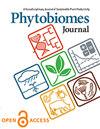Viruses of nitrogen-fixing Mesorhizobium bacteria in globally distributed chickpea root nodules
IF 2.6
3区 生物学
Q2 MICROBIOLOGY
引用次数: 0
Abstract
Legume nodules are specialized environments on plant roots that are induced and dominated by nitrogen-fixing bacteria. Bacteriophages (phages) in these nodules could potentially provide top-down controls on population size and, therefore, function of nitrogen-fixing symbionts. Here we sought to characterize the diversity and biogeographical patterns of phages that infect nitrogen-fixing Mesorhizobium symbionts isolated from root nodules, leveraging 266 genomes of Mesorhizobium isolated from nodules and 648 nodule metagenomes collected from three species of chickpea plants (Cicer spp.) under different agricultural management practices, spanning eight countries on five continents. We identified 106 phage populations (vOTUs) in Mesorhizobium draft genomes, 37% of which were confirmed as likely prophages. These vOTUs were detected in 64% of the Mesorhizobium-dominated nodule metagenomes and 58% of Mesorhizobium isolates. Per metagenome, 1-16 putative Mesorhizobium vOTUs were detected, with over half of the nodules containing only one such vOTU. The majority of vOTUs were detected exclusively in Ethiopia, followed by India and Morocco, with the lowest richness of putative Mesorhizobium phages in countries that applied industrial Mesorhizobium inoculants to crops. Two vOTUs were identified in five or more countries and in nodules dominated by different strains of Mesorhizobium, suggesting infection of diverse Mesorhizobium hosts and long-term interactions. Beta-diversity of these Mesorhizobium phage assemblages was significantly correlated with the dominant Mesorhizobium strain, but not with measured environmental parameters. Our findings indicate that nitrogen-fixing nodules in chickpea plants can contain distinct viral assemblages, with potential impacts on the nodule microbiome that bear further exploration.全球分布的鹰嘴豆根瘤中固氮中根瘤菌病毒
豆科植物根瘤是植物根系上由固氮细菌诱导和支配的特殊环境。这些结核中的噬菌体(噬菌体)可能提供自上而下的种群规模控制,因此,固氮共生体的功能。在这里,我们试图描述侵染根瘤中固氮中根瘤菌共生体的噬菌体的多样性和生物地理格局,利用从三种鹰嘴豆植物(Cicer spp.)中采集的不同农业管理方式下的根瘤中分离的266个中根瘤菌基因组和648个根瘤菌元基因组,这些物种分布在五大洲的八个国家。我们在中根瘤菌草稿基因组中鉴定出106个噬菌体群体(vOTUs),其中37%被确认为可能的噬菌体。这些vOTUs在64%的中根瘤菌为主的结节宏基因组和58%的中根瘤菌分离株中检测到。每个宏基因组检测到1-16个假定的中根瘤菌vOTU,超过一半的结节只含有一个这样的vOTU。大多数vOTUs仅在埃塞俄比亚检测到,其次是印度和摩洛哥,在将工业中根菌接种剂应用于作物的国家中,假定的中根菌噬菌体丰富度最低。在5个或5个以上的国家和以不同中根菌菌株为主的根瘤中发现了2个vOTUs,表明感染了不同的中根菌宿主并长期相互作用。这些中根菌噬菌体组合的β -多样性与中根菌优势菌株显著相关,但与测量的环境参数无关。我们的研究结果表明,鹰嘴豆植物的固氮根瘤可能含有不同的病毒组合,对根瘤微生物群的潜在影响有待进一步探索。
本文章由计算机程序翻译,如有差异,请以英文原文为准。
求助全文
约1分钟内获得全文
求助全文

 求助内容:
求助内容: 应助结果提醒方式:
应助结果提醒方式:


